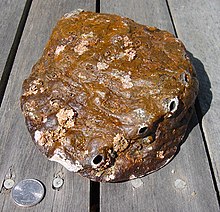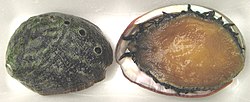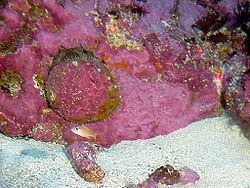Abalone: Difference between revisions
Hybrid (biology)| |
GrahamBould (talk | contribs) mNo edit summary |
||
| Line 101: | Line 101: | ||
==Species== |
==Species== |
||
[[Image:Pinkabalone 300.jpg|thumb|right|250px|Pink abalone, ''Haliotis corrugata'']] |
|||
* ''Haliotis ancile '' : [[Shield abalone]] |
* ''Haliotis ancile '' : [[Shield abalone]] |
||
* ''Haliotis aquatilis'' : [[Japanese abalone]] |
* ''Haliotis aquatilis'' : [[Japanese abalone]] |
||
* ''Haliotis asinina'' : [[Ass’s ear abalone]] |
* ''Haliotis asinina'' : [[Ass’s ear abalone]] |
||
* ''Haliotis assimilis'' : [[Threaded abalone]] |
* ''Haliotis assimilis'' : [[Threaded abalone]][[Image:Pinkabalone 300.jpg|thumb|right|250px|Pink abalone, ''Haliotis corrugata'']] |
||
* ''[[Haliotis australis]]'' : [[Australian abalone]], Austral abalone |
* ''[[Haliotis australis]]'' : [[Australian abalone]], Austral abalone |
||
* ''Haliotis brazieri '': [[Brazier’s abalone]] |
* ''Haliotis brazieri '': [[Brazier’s abalone]] |
||
* ''Haliotis coccoradiata '' : [[Reddish-rayed abalone]] |
* ''Haliotis coccoradiata '' : [[Reddish-rayed abalone]] |
||
* ''Haliotis conicopora '' : [[Conical Pore abalone]], brownlip abalone |
* ''Haliotis conicopora '' : [[Conical Pore abalone]], brownlip abalone |
||
Revision as of 08:45, 10 January 2008
- For other uses, see Abalone (disambiguation).
| Abalone | |
|---|---|

| |
| The shell of a red abalone | |
| Scientific classification | |
| Kingdom: | |
| Phylum: | |
| Class: | |
| Subclass: | |
| Superorder: | |
| Order: | |
| Superfamily: | |
| Family: | Haliotidae Rafinesque, 1815
|
| Genus: | Haliotis Linnaeus, 1758
|
| Species | |
|
Many, see species section. | |



Abalone (from Spanish Abulón) are a group of shellfish (mollusks) in the family Haliotidae and the Haliotis genus. They are marine snails, and belong to the suborder Rhipidoglossa (in earlier classifications) in the large class Gastropoda. There is only one genus in the family Haliotidae, and about four to seven subgenera. The taxonomy of the family is still somewhat confused. The number of species recognized world-wide ranges from about 100 to 130 (due to the occurrence of hybrids).
Abalone shells have a low and open spiral structure, and are characterized by several respiratory holes in a row near the shell's outer edge. The innermost layer of the shell is composed of nacre or mother-of-pearl, which in many species is highly iridescent, giving rise to a range of strong and changeable colors which make them attractive to humans as a decorative object. The flesh of certain large abalones is considered by many to be a desirable food.
Abalones are also called ear-shells, haliotis, sea-ears and Venus's-ears, as well as muttonfish or muttonshells in Australia, ormer in Jersey and Guernsey, perlemoen in South Africa and pāua in New Zealand.
Description
The Haliotid family has a worldwide distribution, being found in some areas along the coastal waters of every continent, except the Atlantic coast of South America, the Caribbean (where there is only one rather rare, deep water species), and the East Coast of the United States. Most abalones are found mainly in cold waters, off the Southern Hemisphere coasts of New Zealand, South Africa and Australia, and Western North America and Japan in the Northern Hemisphere.
The family has unmistakable characteristics: the shell is convex, covering the animal like a roof. It ranges from highly arched to very flattened, rounded to oval, slightly spiral with two to three whorls, the last one auriform grown into a large "ear", giving rise to the common name ‘ear-shell’. The body whorl has a series of holes — four to ten depending on the species — near the anterior margin, for the escape of water from the gills. There is no operculum.
The color is very variable from species to species. The iridescent nacre that lines the inside of the shell in all species can vary in color from silvery white, to pink, red and green-red, through to Haliotis iris, which shows predominantly deep blues, greens and purples.
These shells cling with their broad muscular foot to rocky surfaces at sublittoral depths. Abalones reach maturity at a relatively small size. Their fecundity is high and increases with size (from 10,000 to 11 million eggs at a time).
The larvae are lecithotrophic or feed off a yolk sac. The adults are herbivorous and feed with their rhipidoglossan radula on macroalgae, preferring red algae. Sizes vary from 20 mm (Haliotis pulcherrima) to 200 mm (or even more) (Haliotis rufescens).
Distribution and characteristics
The Haliotid family has a worldwide distribution, along the coastal waters of every continent, except the Atlantic coast of South America, the Caribbean, and the East Coast of the United States. Most abalones are found mainly in cold waters, off the Southern Hemisphere coasts of New Zealand, South Africa and Australia, and Western North America and Japan in the Northern Hemisphere. In the Chilean vast Pacific coast, the giant species called loco (Concholepas Concholepas, Bruguière, 1789) is notorious for its size (usually more than double the size of Californian and/or Japanese abalones), has a hard shell of a pitch-black color, and is widely exploited and consumed.
The family has unmistakable characteristics : the shell is rounded to oval, with two to three whorls, and the last one auriform, grown into a large "ear", giving rise to the common name ‘ear-shell’. The body whorl has a series of holes — four to ten depending on the species, near the anterior margin.
There is no operculum. The back is convex, ranging from highly arched to very flattened. These shells cling solidly with their muscular foot to rocky surfaces at sublittoral depths. The color is very variable from species to species. The inside of the shell consists of iridescent, silvery white to green-red mother-of-pearl through to Haliotis Iris which can comprise of pinks and reds with predominant deep blues, greens and purples.
Abalones reach maturity at a small size. Their fecundity is high and increases with size (from 10,000 to 11 million eggs at a time).
The larvae feed on plankton. The adults are herbivores and feed on macroalgae, preferring red algae. Sizes vary from 20 mm (Haliotis pulcherrima) to 200 mm (or even more) (Haliotis rufescens).
Care must be taken in handling abalone; like many mollusks, abalone are hemophiliacs and due to the lack of clotting, can bleed to death. The abalone's main defense is its muscular foot that firmly plants it to the substrate and its shell.
Abalone shell
The shell of the abalone is known for being exceptionally strong. It is made of microscopic calcium carbonate tiles stacked like bricks. Between the layers of shells is a clingy protein substance. When the abalone shell is struck, the tiles slide instead of shattering and the protein stretches to absorb the energy of the blow. Material scientists at the University of California, San Diego are studying the tiled structure for insight into stronger ceramic products such as body armor.[1]
The dust created through the grinding and cutting of abalone shell is dangerous; appropriate safeguards should be taken to protect a person from inhaling these particles. A dust respirator that is NIOSH-approved N95, made for fine particles, using a ventilation system and wet grinding are requirements to working the shell safely. The calcium carbonate is a respiratory irritant and the particles can penetrate into the lower respiratory tree and cause irritant bronchitis and other respiratory irritation responses. The usual symptoms are cough and sputum production, and secondary infections can occur. If there are proteins left in the shell matrix, it is also possible that they can trigger an allergic (asthmatic) attack. In general, the more someone is exposed to something that triggers their asthma reaction, the larger the reaction. Allergic skin reactions can also occur.
The iridescence of the inside of the abalone shell lends itself to decorative inlays — in guitars, for example.
Sport harvesting
California

Sport harvesting of red abalone is permitted with a California fishing license and an abalone stamp card. Abalone may only be taken using breath-hold techniques or shorepicking. Scuba diving for abalone is strictly prohibited. Taking of abalone is not permitted south of the mouth of the San Francisco Bay. There is a size minimum of seven inches measured across the shell and a quantity limit of three per day and 24 per year. A person may be in possession of only three abalone at any given time.
Abalone may only be taken from April to November, not including July. Transportation of abalone may only legally occur while the abalone is still attached in the shell. Sale of sport-obtained abalone is illegal, including the shell. Only red abalone may be taken; black, white, pink, and flat abalone are protected by law.
An abalone diver is normally equipped with a thick wetsuit, including a hood, booties, and gloves. He or she would also wear a mask, snorkel, weight belt, abalone iron, and abalone gauge. It is common to take abalone in water a few inches deep up to 10 m (33 ft) deep; less common are freedivers who can work deeper than 10 m (33 ft). Abalone are normally found on rocks near food sources (kelp). An abalone iron is used to pry the abalone from the rock before it can fully clamp down. Visibility is normally five to ten feet. Divers commonly dive out of boats, kayaks, tube floats or directly off the shore. An eight inch abalone is considered a good catch, a nine inch would be extremely good, and a ten inch plus (250 mm) abalone would be a trophy catch. Rock- or shore-picking is a separate method from diving where the rock picker feels underneath rocks at low tides for abalone.
There has been a trade in diving to catch abalones off parts of the United States coast from before 1939. In World War II, many of these abalone divers were recruited into the United States armed forces and trained as frogmen.
The largest abalone recorded in California is 12.34 inches, caught by John Pepper somewhere off the coast of Humboldt county.
New Zealand

There is an extensive global black market in the collection and export of abalone meat. In New Zealand, where abalone is called pāua in the Māori language, this can be a particularly awkward problem where the right to harvest pāua can be granted legally under Māori customary rights. When such permits to harvest are abused, it is frequently difficult to police. The legal recreational daily limit is 10 pāua per diver with a minimum shell length of 125 mm. The limit is strictly enforced by roving Ministry of Fisheries officers with the backing of the police. Pāua 'poaching' is a major industry in New Zealand with many thousands being taken illegally, often undersized. Convictions have resulted in seizure of diving gear, boats, and motor vehicles as well as fines and in rare cases, imprisonment. The Ministry of Fisheries expects in the year 2004/05, nearly 1,000 tons of pāua will be poached, with 75% of that being undersized.[1]
Highly polished New Zealand pāua shells are extremely popular as souvenirs with their striking blue, green, and purple iridescence. Transporting unprocessed abalone shells out of New Zealand is illegal.
South Africa
The largest abalone in South Africa, the perlemoen, Haliotis midae, occurs along approximately two-thirds of the country’s coastline. Perlemoen-diving has been a recreational activity for many years, but stocks are currently being threatened by illegal commercial harvesting. In South Africa all persons collection / hunting (spearfishing) and/or fishing need permits that are issued on a yearly basis. Also none of these activities are allowed on Scuba. For the last few years however no permits have been issued for collecting Abalone (perlemoen). But commercial harvesting still continues as does the very large and illegal collection by small gangs.
Channel Islands
Ormers (Haliotis tuberculata) are considered a delicacy in the British Channel Islands and are pursued with great alacrity by the locals. This has led to a dramatic depletion in numbers since the latter half of the 19th century, and 'ormering' is now strictly regulated in order to preserve stocks. The gathering of ormers is now restricted to a number of 'ormering tides', from the January 1 to April 30, which occur on the full or new moon and two days following. No ormers may be taken from the beach that are under 80 mm in shell length. Gatherers are not allowed to wear wetsuits or even put their heads underwater. Any breach of these laws is a criminal offence and can lead to fine of up to £5,000 or six months in prison [2]. The demand for ormers is such that they led to the world's first underwater arrest, when Mr. Kempthorne-Leigh of Guernsey was arrested by a police officer in full diving gear when illegally diving for ormers.
Farming
Farming of abalone began in the late 1950's and early 1960's in Japan and China.[2] Since the mid-1990's, there have been many increasingly successful endeavors to commercially farm abalone for the purpose of consumption.[3] Over-fishing and poaching have reduced wild populations to such an extent that farmed abalone now supplies most of the abalone meat consumed. The principal abalone farming countries are China, Taiwan and Japan. Abalone is also farmed in Australia, Chile, Iceland, Ireland, Mexico, New Zealand, South Africa, Thailand, and the United States. [4]
Consumption

The meat of this mollusk is considered a delicacy in certain parts of Latin America (especially Chile), New Zealand, South East Asia, and East Asia (especially in China, Japan, and Korea). In Chinese speaking regions, abalone are commonly known as bao yu, and sometimes forms part of a Chinese banquet. Similar to shark fin soup, it is considered a symbol of wealth and prestige, and is traditionally reserved for special occasions such as weddings and other celebrations. However, the availability of commercially farmed abalone has allowed more common consumption of this once rare delicacy.
Species
- Haliotis ancile : Shield abalone
- Haliotis aquatilis : Japanese abalone
- Haliotis asinina : Ass’s ear abalone
- Haliotis assimilis : Threaded abalone

Pink abalone, Haliotis corrugata - Haliotis australis : Australian abalone, Austral abalone
- Haliotis brazieri : Brazier’s abalone
- Haliotis coccoradiata : Reddish-rayed abalone
- Haliotis conicopora : Conical Pore abalone, brownlip abalone
- Haliotis corrugata : Pink abalone
- Haliotis cracherodii : Black abalone
- Haliotis crebrisculpta : Close sculptures abalone
- Haliotis cyclobates : Whirling abalone
- Haliotis dalli : Dall’s abalone
- Haliotis discus : Disk abalone
- Haliotis diversicolor : Variously coloured abalone
- Haliotis diversicolor supertexta : Taiwan abalone (jiukong)
- Haliotis dohrniana : Dhorn’s abalone
- Haliotis elegans : Elegant abalone

White abalone, Haliotis sorenseni
- Haliotis emmae : Emma’s abalone
- Haliotis ethologus : Mimic abalone
- Haliotis fulgens : Green abalone
- Haliotis gigantea : Giant abalone, Awabi
- Haliotis glabra : Glistening abalone
- Haliotis hargravesi : Hargraves’s abalone
- Haliotis howensis : Lord Howe abalone
- Haliotis iris : Blackfoot abalone
- Haliotis iris : Rainbow abalone, Pāua
- Haliotis jacnensis : Jacna abalone
- Haliotis kamschatkana : Pinto abalone
- Haliotis laevigata : smooth Australian abalone, greenlip abalone
- Haliotis melculus : Honey Abalone
- Haliotis midae : Midas ear abalone, perlemoen abalone
- Haliotis multiperforata : Many-holed abalone
- Haliotis ovina : Oval abalone, sheep's ear abalone
- Haliotis parva : Canaliculate abalone
- Haliotis planata : Planate abalone
- Haliotis pourtalesii : Pourtale’s abalone
- Haliotis pulcherrima : Most beautiful abalone
- Haliotis queketti : Quekett’s abalone
- Haliotis roei : Roe's abalone
- Haliotis rosacea: Rosy abalone
- Haliotis rubra : Ruber abalone
- Haliotis rufescens: Red abalone
- Haliotis scalaris : Staircase abalone, ridged ear abalone
- Haliotis semiplicata : Semiplicate abalone
- Haliotis sorenseni : White abalone
- Haliotis spadicea : Blood-spotted abalone
- Haliotis speciosa : Splendid abalone
- Haliotis squamata : Scaly Australian abalone
- Haliotis squamosa : Squamose abalone
- Haliotis tuberculata : Green ormer, European edible abalone, tube abalone, tuberculate ormer
- Haliotis varia : Variable abalone
- Haliotis venusta : Lovely abalone
- Haliotis virginea : Virgin abalone
- Haliotis walallensis : Northern green abalone, flat abalone
Other species : Haliotis clathrata, Haliotis barbouri, Haliotis crebrisculpta, Haliotis dissona, Haliotis exigua, Haliotis fatui, Haliotis kamtschatkana assimilis, Haliotis kamtschatkana kamtschatkana, Haliotis madaka, Haliotis mariae, Haliotis patamakanthini, Haliotis pustulata, Haliotis roberti, Haliotis rubiginosa, Haliotis rubra, Haliotis rugosa, Haliotis thailandis, Haliotis unilateralis.
Notes
- ^ Lin, A. (2005). "Growth and structure in abalone shell". Materials Science and Engineering A. 390 (Jan. 15): 27–41. Retrieved 2006-05-31.
{{cite journal}}: Unknown parameter|coauthors=ignored (|author=suggested) (help) - ^ "Abalone Farming Information". Retrieved 2007-11-08.
- ^ "Abalone Farming on a Boat". Retrieved 2007-01-27.
- ^ "Abalone Farming Around the World". Retrieved 2007-11-08.
External links
- California red abalone
- Bullet proof abalone
- Abalone biology
- Online Archive of California
- Conchology
- Specimen shells; Many pictures.
- New Zealand natural abalone (paua) pearls; interesting pictures.
- Man and mollusk : many links
- Natural abalone "horn" pearls : sample photos
- Imagemap of worldwide abalone distribution
- Hardy's Internet Guide to Marine Gastropods : Shell Catalog
- Abalone: Species Diversity
- Team spawns rare white abalone
- White abalone - An extinct possibility?
- Muricidae - Concholepas
- Avoiding offshore transport of competent larvae during upwelling events: the case of the gastropod Concholepas concholepas in Central Chile
- Northern California Community of Abalone Free Divers


